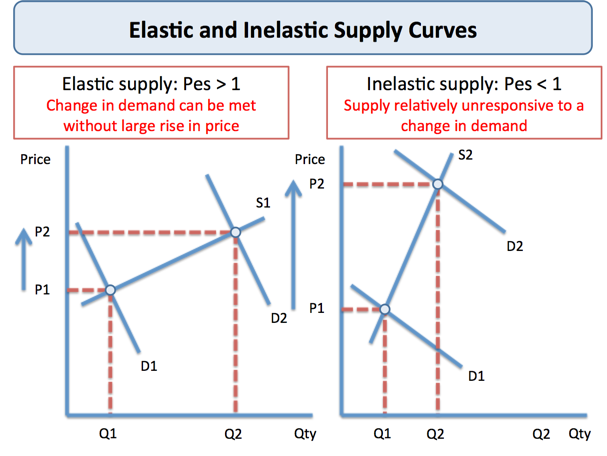Explaining Price Elasticity of Supply
Price elasticity of supply (PES) measures the relationship between change in quantity supplied following a change in price
- If supply is elastic (i.e. PES > 1), then producers can increase output without a rise in cost or a time delay
- If supply is inelastic (i.e. PES <1), then firms find it hard to change production in a given time period.
What is the formula for calculating price elasticity of supply?
The formula for price elasticity of supply is:
Percentage change in quantity supplied divided by the percentage change in price
- When Pes > 1, then supply is price elastic
- When Pes < 1, then supply is price inelastic
- When Pes = 0, supply is perfectly inelastic
- When Pes = infinity, supply is perfectly elastic following a change in demand
An elastic supply curve

What factors affect the elasticity of supply?
- Spare production capacity: If there is plenty of spare capacity then a business can increase output without a rise in costs and supply will be elastic in response to a change in demand. The supply of goods and services is most elastic during a recession, when there is plenty of spare labour and capital resources.
- Stocks of finished products and components: If stocks of raw materials and finished products are at a high level then a firm is able to respond to a change in demand - supply will be elastic. Conversely when stocks are low, dwindling supplies force prices higher because of scarcity
- The ease and cost of factor substitution/mobility: If both capital and labour are occupationally mobile then the elasticity of supply for a product is higher than if capital and labour cannot easily be switched. E.g. a printing press which can switch easily between printing magazines and greetings cards. Or falling prices of cocoa encourage farmers to switch into rubber production
- Time period and production speed: Supply is more price elastic the longer the time period that a firm is allowed to adjust its production levels. In some agricultural markets the momentary supply is fixed and is determined mainly by planting decisions made months before, and also climatic conditions, which affect the production yield. In contrast the supply of milk is price elastic because of a short time span from cows producing milk and products reaching the market place.

Summary of key factors affecting price elasticity of supply

Here are some topical applications of the concept of price elasticity of supply

Comments
Post a Comment